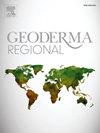A comparison of country-scale subsoil predictions between a numeric and a taxonomic soil classification system
IF 3.1
2区 农林科学
Q2 SOIL SCIENCE
引用次数: 0
Abstract
Traditional soil classification systems are designed to communicate information; however, surveyor biases and tacit knowledge can lead to subjective soil class designations. Consequently, different soil scientists may classify the same soil differently. This becomes a critical issue when mapping soil classes, as there could be multiple interpretations for the same observation. To address this problem, numerical soil classification systems have been developed. However, little is known about how well they compare to taxonomic systems when spatially predicted on a national scale. This study aimed to compare a previously developed, unsupervised numeric classification system and South Africa's taxonomic soil classification system in terms of their spatial predictions across the country. The taxonomic system of South Africa has 19 defined subsoil horizons, which were aggregated into eight horizons and compared to a nine horizon numeric classification as well as South Africa's profile (soil form) classification comprising of 73 different soil groupings, which was used as a control. The comparison was conducted from predictions through gradient tree boosting in Google Earth Engine at a 30 m resolution. The numerical system (kappa = 0.30, accuracy = 0.57) exhibited poor spatial predictions, with a kappa 22% lower and accuracy 2% lower than the control (kappa = 0.52, accuracy = 59%). On the other hand, the taxonomic system performed well, with a kappa of 0.57 and an accuracy of 67%, exhibiting a 5% increase in kappa and an 8% increase in accuracy compared to the control. It was hypothesized that the overpredictions of the predominant horizon contributed to the numeric system's poor performance. Nevertheless, both systems showed the highest maximum entropy in arid regions of the Karoo and savannah biomes, albeit in spatially distinct ecoregions. It was thought that the divergence in the two systems' maximum entropy was due to their association with precipitation differences (amount and seasonality) as well as vegetation type and cover (woodlands vs. shrublands). To map the country in more detail, further soil sampling should be conducted in arid regions and optimisation of the predictive algorithm for each soil category should be performed.
数值土壤分类系统与分类学土壤分类系统在国家尺度下的底土预测比较
传统土壤分类系统的设计目的是传递信息;然而,测量员的偏见和隐性知识可能导致主观的土壤类别指定。因此,不同的土壤学家对同一种土壤的分类可能不同。这在绘制土壤类别时成为一个关键问题,因为同一观测结果可能有多种解释。为了解决这个问题,数值土壤分类系统已经被开发出来。然而,当在全国范围内进行空间预测时,它们与分类学系统的比较效果如何,人们知之甚少。本研究旨在比较先前开发的无监督数字分类系统和南非的土壤分类系统在全国范围内的空间预测。南非的分类系统有19个确定的底土层,这些层被汇总为8个层,并与9个层的数字分类以及南非的剖面(土壤形式)分类进行比较,该分类由73个不同的土壤分组组成,作为对照。比较了谷歌Earth Engine在30 m分辨率下通过梯度树增强的预测结果。数值系统(kappa = 0.30,准确率= 0.57)的空间预测能力较差,kappa比对照组(kappa = 0.52,准确率= 59%)低22%,准确率低2%。另一方面,该分类系统表现良好,kappa为0.57,准确率为67%,kappa比对照提高了5%,准确率提高了8%。据推测,对主要视界的过度预测导致了数值系统性能不佳。然而,两个系统的最大熵值在卡鲁和稀树草原的干旱区最高,尽管在空间上不同的生态区域。人们认为,两个系统最大熵的差异是由于它们与降水差异(数量和季节性)以及植被类型和覆盖度(林地与灌丛)有关。为了更详细地绘制该国地图,应在干旱地区进行进一步的土壤采样,并对每种土壤类别的预测算法进行优化。
本文章由计算机程序翻译,如有差异,请以英文原文为准。
求助全文
约1分钟内获得全文
求助全文
来源期刊

Geoderma Regional
Agricultural and Biological Sciences-Soil Science
CiteScore
6.10
自引率
7.30%
发文量
122
审稿时长
76 days
期刊介绍:
Global issues require studies and solutions on national and regional levels. Geoderma Regional focuses on studies that increase understanding and advance our scientific knowledge of soils in all regions of the world. The journal embraces every aspect of soil science and welcomes reviews of regional progress.
 求助内容:
求助内容: 应助结果提醒方式:
应助结果提醒方式:


